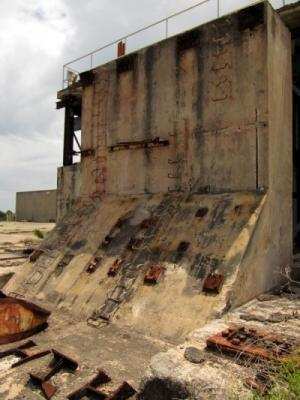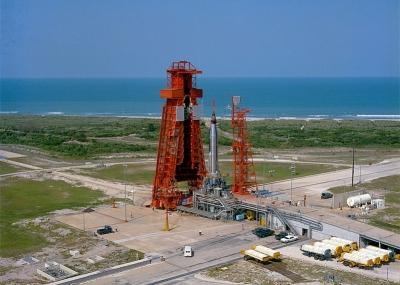But Finds That Loving An Idea Sometimes Just Isn't Enough
Nearly two years ago, Jen Scheer, former Space Shuttle Program
technician, toured the launch complexes at Cape Canaveral Air Force
Station, adjacent to Kennedy Space Center (KSC). She visited a
number of sites, but one in particular stuck in her mind. The site
was Launch Complex 14, best known as the place where John Glenn
lifted off in his Mercury capsule, Friendship 7, to become the
first American to orbit the Earth in 1962. The decomposition of the
complex over time was apparent. “It was sad to see it in this
state,” she said. “It didn’t seem to be a fitting
tribute to what was accomplished there.”
Deteriorated Launch Complex 14 Photo By
Jen Scheer

Scheer left thinking about the complex. Wouldn’t it be
cool to do something with the site? Not a huge fan of just erecting
monuments, Scheer wanted to find a way to make the complex come
alive—to make it a trip back in time, an educational
experience relevant to today’s space exploration industry.
She thought about the retirement of shuttle, the kids sitting in
classrooms, the workforce that would be lost, and the knowledge and
know-how that would be lost. “I was worried that when
we’ll need it, it won’t be there anymore,” she
said.
And then an idea came to her, one that would create jobs,
educate kids, and inspire the next generation of explorers.
She called it “Project Mercury Rising“. The idea was
to restore Complex 14 to look like it did in the height of the
Mercury program and stand up an educational program there designed
to teach teens the engineering and hands-on technical skills needed
for space flight. Participants would master the basics using
Mercury replica hardware, then move on to small modern payloads-
which would be launched by a partner organization. On paper, it
made perfect sense. The program would employ members of the shuttle
workforce about to be laid off, facilitate the transfer of valuable
technical skills and knowledge, and engage kids in hands-on
learning in the context of a historic program.
“You’re honoring what happened there at that
site,” said Scheer. “It worked on so many different
levels; I thought it would be perfect.”
Scheer did what many people do when gripped by a good idea: she
spread it. She talked to anyone who would listen: industry leaders,
politicians, astronauts, teachers, people at NASA, people outside
of NASA. They all told her the idea was great. The interest and
enthusiasm were there. However, Scheer quickly had an important
realization. “Everybody loved the idea,” she said,
“But just loving the idea isn’t enough.”
Scheer knew that realizing her idea would come with many
challenges. She knew what she had: an idea, enthusiasm, and
interest. She also knew what she needed: access, permission,
partners, a team, funding, and most of all, a business plan to tie
it all together. “The site itself is a bit of a
challenge,” she said. “It isn’t just a place for
people to come to and play.” She needed to sort out
permission to the site.
She honed her skills of persuasion and started to build up
healthy alliances with people onsite and off. Perhaps, she thought,
Space Camp would see value in it. With the retirement of the
shuttle, the program might be looking for something new. Perhaps
she could partner with technical training programs or the local and
state government. Kids could go through the program and walk out
with a marketable skill. “You’d have to show value to
the parents,” Scheer said. She envisioned different tracks,
including technical, engineering, life sciences, and even science
journalism.
People expressed interest in becoming part of a team.
“Lots of people wanted to help, but you’ve got to have
things to give them to do,” she said. However, the project
was so early in its life cycle that it was difficult to assign
specific tasks to anyone.
She even had the promise of funding from partners, but she
needed a business plan. One organization recommended that Scheer
seek the help of the local small business development center. She
heeded their advice and attended a course there on business
planning. “It didn’t pertain to what I was trying to do
whatsoever,” she said, noting that it focused on businesses
making widgets or opening up a restaurant. Scheer’s project
was different, and she didn’t have the business plan to tame
it. “The whole thing stalled out at the business plan. You
need the business plan to get the money,” explained Scheer.
“Nobody is going to give you money without a business plan
and this is where I really needed help.”
Lauch Complex 14 NASA Photo

Scheer left the shuttle program in 2010. Even out of work,
Scheer was busy to the point of having no free time. She was
writing a book, taking photographs of KSC every morning,
volunteering at a local space museum, visiting classrooms virtually
through Skype interviews, and managing the Space Tweep Society, to
name a few. Her skill set brought her numerous other opportunities
as well, so many that she kept a folder in her email titled OPP:
“Other Peoples’ Projects” to keep track of all of
the projects others wanted her to contribute to.
She had yet to harness the power that sets seasoned project
managers apart: the ability to say no. Because she was doing so
many things, Project Mercury Rising started to idle. “When
you’re trying to work on something and are constantly
bombarded with other proposals, the project suffers” she
said.
Interest in the project is still alive and well.
“I’ve even had a lot of adults tell me that they want
to go to this camp,” laughed Scheer. “It should
happen,” she said, “whether it’s me that does it,
or some corporation that decides that it’s a good idea and
wants to do it.” She has never been possessive of the idea.
“I don’t mind if somebody else takes the idea and runs
with it.”
Stioll, Project Mercury Rising is an example of how a good idea
alone is not enough. Effective management, networking, fundraising,
and communication skills are all vital to launch a unique project
that doesn't fit an existing business model. Opportunities for
young professionals to develop these capabilities are not always
easy to find. “A mentor in the space industry with knowledge
of business planning would have been invaluable,” Scheer
said. “It would have made all the difference in the
world.”
 ANN's Daily Aero-Linx (04.16.24)
ANN's Daily Aero-Linx (04.16.24) Aero-News: Quote of the Day (04.16.24)
Aero-News: Quote of the Day (04.16.24) Airborne 04.10.24: SnF24!, A50 Heritage Reveal, HeliCycle!, Montaer MC-01
Airborne 04.10.24: SnF24!, A50 Heritage Reveal, HeliCycle!, Montaer MC-01 Airborne 04.12.24: SnF24!, G100UL Is Here, Holy Micro, Plane Tags
Airborne 04.12.24: SnF24!, G100UL Is Here, Holy Micro, Plane Tags Airborne-Flight Training 04.17.24: Feds Need Controllers, Spirit Delay, Redbird
Airborne-Flight Training 04.17.24: Feds Need Controllers, Spirit Delay, Redbird




